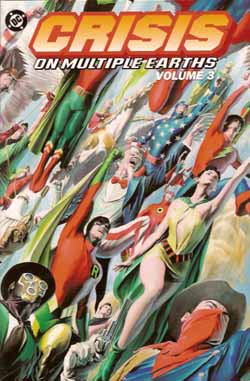 Â
Â
By Various (DC Comics)
ISBN 1-84023-946-8
I’m going to “cop a plea†on this book. Like any other comic book geek who grew up in the 1960’s and early 1970’s I was captivated by gaudy costumes and the outrageous battles to save the city, the country, the world, the universe, the multiverse, et al, ad nauseam. I loved all this stuff. I loved the funny animals, the comedies, suspense and horror stories, the Sci-Fi. Newspaper strips, Annuals, Albums, American, British, whatever. I even liked the romance stories which usually demanded a much higher standard of drawing than all other types of comic strip.
In regard to comic material from this period I cannot declare myself an impartial critic. That counts doubly so for the Julie Schwartz edited Justice League of America and its annual summer tradition of teaming up with its progenitor organisation, the Justice Society of America. If that sounds a tad confusing there are many places to look for clarifying details. If you’re interested in superheroes and their histories you’ll even enjoy the search. But this is not the place for that.
This volume reprints get-togethers from 1971 through 1974, tightly plotted tales comfortably rendered by the tragically under-rated Dick Dillin, although perhaps sometimes uncomfortably scripted in the vernacular of the day (“Right on brother,†says one white superhero to another white superhero!). There are adventures featuring inter-dimensional alien symbiotes and swamp monster Solomon Grundy (JLA #91-92), evil geniuses and the time-marooned team of 1940’s superheroes called the Seven Soldiers of Victory (JLA #100-102), an accidental detour to a parallel Earth where the Nazis won the second World War and the meeting with yet another team of 1940’s characters, the Freedom Fighters (JLA#107-108), and a genuinely poignant tale of good intentions gone awry featuring the Golden Age Sandman (JLA# 114).
In terms of “super†genre the writing consists of two bunches of heroes who get together to deal with extra-extraordinary problems. In hindsight, it’s obviously also about sales and the attempted revival of more super characters during a period of intense sales rivalry between DC Comics and Marvel. But for those who love costume heroes, who crave these carefully constructed modern mythologies and care, it is simply a grand parade of simple action, great causes and momentous victories.
I love ’em, not because they’re the best of their kind, but because I did then and they haven’t changed even if I have. Do you fancy trying to find your Inner Kid again?
© 1971, 1972, 1973, 1974, 2004 DC Comics. All rights reserved.
